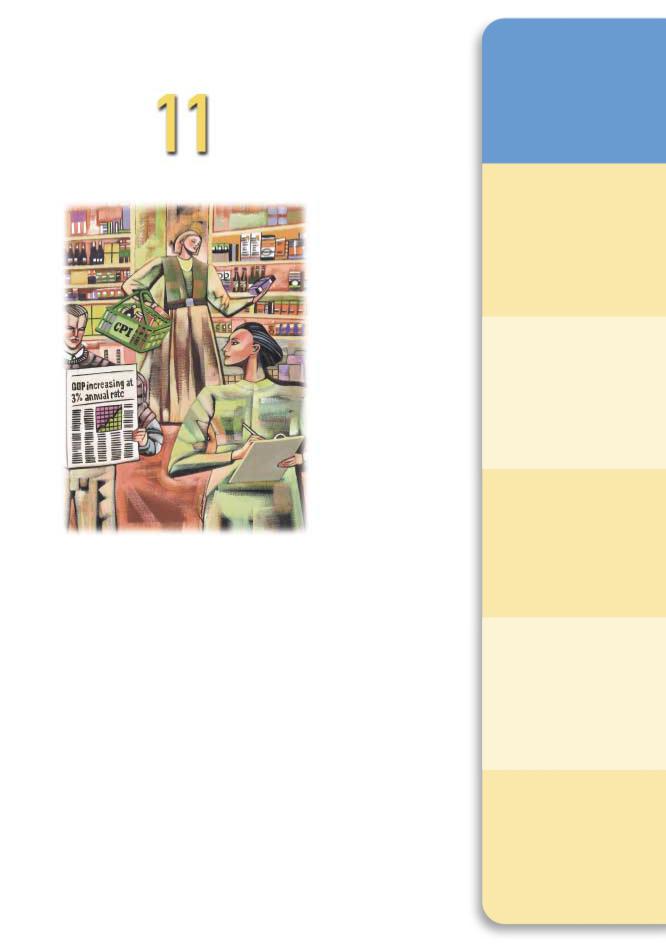
Mankiw Principles of Macroeconomics (3rd ed)
.pdf
218 |
PART FOUR THE DATA OF MACROECONOMICS |
GDP REFLECTS THE FACTORY’S PRODUCTION, BUT NOT THE HARM THAT IT INFLICTS ON THE ENVIRONMENT.
GDP is not, however, a perfect measure of well-being. Some things that contribute to a good life are left out of GDP. One is leisure. Suppose, for instance, that everyone in the economy suddenly started working every day of the week, rather than enjoying leisure on weekends. More goods and services would be produced, and GDP would rise. Yet, despite the increase in GDP, we should not conclude that everyone would be better off. The loss from reduced leisure would offset the gain from producing and consuming a greater quantity of goods and services.
Because GDP uses market prices to value goods and services, it excludes the value of almost all activity that takes place outside of markets. In particular, GDP omits the value of goods and services produced at home. When a chef prepares a delicious meal and sells it at his restaurant, the value of that meal is part of GDP. But if the chef prepares the same meal for his spouse, the value he has added to the raw ingredients is left out of GDP. Similarly, child care provided in day care centers is part of GDP, whereas child care by parents at home is not. Volunteer work also contributes to the well-being of those in society, but GDP does not reflect these contributions.
Another thing that GDP excludes is the quality of the environment. Imagine that the government eliminated all environmental regulations. Firms could then produce goods and services without considering the pollution they create, and GDP might rise. Yet well-being would most likely fall. The deterioration in the quality of air and water would more than offset the gains from greater production.
GDP also says nothing about the distribution of income. A society in which 100 people have annual incomes of $50,000 has GDP of $5 million and, not surprisingly, GDP per person of $50,000. So does a society in which 10 people earn $500,000 and 90 suffer with nothing at all. Few people would look at those two situations and call them equivalent. GDP per person tells us what happens to the average person, but behind the average lies a large variety of personal experiences.
In the end, we can conclude that GDP is a good measure of economic wellbeing for most—but not all—purposes. It is important to keep in mind what GDP includes and what it leaves out.
CASE STUDY INTERNATIONAL DIFFERENCES IN GDP AND THE QUALITY OF LIFE
One way to gauge the usefulness of GDP as a measure of economic well-being is to examine international data. Rich and poor countries have vastly different levels of GDP per person. If a large GDP leads to a higher standard of living, then we should observe GDP to be strongly correlated with measures of the quality of life. And, in fact, we do.
Table 10-3 shows 12 of the world’s most populous countries ranked in order of GDP per person. The table also shows life expectancy (the expected life span at birth) and literacy (the percentage of the adult population that can read). These data show a clear pattern. In rich countries, such as the United States, Japan, and Germany, people can expect to live into their late seventies, and almost all of the population can read. In poor countries, such as Nigeria, Bangladesh, and Pakistan, people typically live only until their fifties or early sixties, and only about half of the population is literate.
Although data on other aspects of the quality of life are less complete, they tell a similar story. Countries with low GDP per person tend to have more infants with low birth weight, higher rates of infant mortality, higher rates of

CHAPTER 10 MEASURING A NATION’S INCOME |
219 |
|
REAL GDP PER |
LIFE |
ADULT |
COUNTRY |
PERSON, 1997 |
EXPECTANCY |
LITERACY |
|
|
|
|
United States |
$29,010 |
77 years |
99% |
Japan |
24,070 |
80 |
99 |
Germany |
21,260 |
77 |
99 |
Mexico |
8,370 |
72 |
90 |
Brazil |
6,480 |
67 |
84 |
Russia |
4,370 |
67 |
99 |
Indonesia |
3,490 |
65 |
85 |
China |
3,130 |
70 |
83 |
India |
1,670 |
63 |
53 |
Pakistan |
1,560 |
64 |
41 |
Bangladesh |
1,050 |
58 |
39 |
Nigeria |
920 |
50 |
59 |
|
|
|
|
Table 10-3
GDP, LIFE EXPECTANCY, AND
LITERACY. The table shows GDP per person and two measures of the quality of life for 12 major countries.
Source: Human Development Report 1999, United Nations.
IN THE NEWS
Hidden GDP
ment red tape, and the simple desire to sock away some extra cash have driven much of Russia’s economic activity underground.
For the last six years, the Russian economy has been going down, down, down. But as President Boris N. Yeltsin tries to deliver the growth he has promised, economists are taking a closer look at the murky but vibrant shadow economy. It includes everything from small businesses that never report their sales to huge companies that understate their production to avoid taxes.
experts insist that if the economy is taken into account, economy is finally starting to Mr. Yeltsin’s critics comnew calculations are more
than economics. . . .
no question that measuring activity in a former Communist the road to capitalism is a
elusive task.
“There is a serious problem with post-socialist statistics,” said Yegor T. Gaidar, the former Prime Minister and pro-reform director of the Institute of Economic Problems of the Transitional Period.
“Seven years ago to report an increase in the amount of production was to become a Hero of Socialist Labor,” he said. “Now it is to get additional visits from the tax collector.”
SOURCE: The New York Times, May 18, 1997, Week in Review, p. 4.

220 |
PART FOUR THE DATA OF MACROECONOMICS |
maternal mortality, higher rates of child malnutrition, and less common access to safe drinking water. In countries with low GDP per person, fewer school-age children are actually in school, and those who are in school must learn with fewer teachers per student. These countries also tend to have fewer televisions, fewer telephones, fewer paved roads, and fewer households with electricity. International data leave no doubt that a nation’s GDP is closely associated with its citizens’ standard of living.
QUICK QUIZ: Why should policymakers care about GDP?
CONCLUSION
This chapter has discussed how economists measure the total income of a nation. Measurement is, of course, only a starting point. Much of macroeconomics is aimed at revealing the long-run and short-run determinants of a nation’s gross domestic product. Why, for example, is GDP higher in the United States and Japan than in India and Nigeria? What can the governments of the poorest countries do to promote more rapid growth in GDP? Why does GDP in the United States rise rapidly in some years and fall in others? What can U.S. policymakers do to reduce the severity of these fluctuations in GDP? These are the questions we will take up shortly.
At this point, it is important to acknowledge the importance of just measuring GDP. We all get some sense of how the economy is doing as we go about our lives. But the economists who study changes in the economy and the policymakers who formulate economic policies need more than this vague sense—they need concrete data on which to base their judgments. Quantifying the behavior of the economy with statistics such as GDP is, therefore, the first step to developing a science of macroeconomics.
Summar y
Because every transaction has a buyer and a seller, the total expenditure in the economy must equal the total income in the economy.
Gross domestic product (GDP) measures an economy’s total expenditure on newly produced goods and services and the total income earned from the production of these goods and services. More precisely, GDP is the market value of all final goods and services produced within a country in a given period of time.
GDP is divided among four components of expenditure: consumption, investment, government purchases, and net exports. Consumption includes spending on goods and services by households, with the exception of
purchases of new housing. Investment includes spending on new equipment and structures, including households’ purchases of new housing. Government purchases include spending on goods and services by local, state, and federal governments. Net exports equal the value of goods and services produced domestically and sold abroad (exports) minus the value of goods and services produced abroad and sold domestically (imports).
Nominal GDP uses current prices to value the economy’s production of goods and services. Real GDP uses constant base-year prices to value the economy’s production of goods and services. The GDP deflator—

CHAPTER 10 MEASURING A NATION’S INCOME |
221 |
calculated from the ratio of nominal to real GDP— measures the level of prices in the economy.
GDP is a good measure of economic well-being because people prefer higher to lower incomes. But it is not a
perfect measure of well-being. For example, GDP excludes the value of leisure and the value of a clean environment.
Key Concepts
microeconomics, p. 206 |
investment, p. 211 |
real GDP, p. 214 |
||
macroeconomics, p. 206 |
government purchases, p. 211 |
GDP deflator, p. 215 |
||
gross domestic product (GDP), p. 208 |
net exports, p. 211 |
|
|
|
consumption, p. 211 |
nominal GDP, p. 214 |
|
|
|
|
|
|
|
|
|
|
Questions for Review |
|
|
|
|
|
|
|
1.Explain why an economy’s income must equal its expenditure.
2.Which contributes more to GDP—the production of an economy car or the production of a luxury car? Why?
3.A farmer sells wheat to a baker for $2. The baker uses the wheat to make bread, which is sold for $3. What is the total contribution of these transactions to GDP?
4.Many years ago Peggy paid $500 to put together a record collection. Today she sold her albums at a garage sale for $100. How does this sale affect current GDP?
5.List the four components of GDP. Give an example of each.
6.Why do economists use real GDP rather than nominal GDP to gauge economic well-being?
7.In the year 2001, the economy produces 100 loaves of bread that sell for $2 each. In the year 2002, the economy produces 200 loaves of bread that sell for $3 each. Calculate nominal GDP, real GDP, and the GDP deflator for each year. (Use 2001 as the base year.) By what percentage does each of these three statistics rise from one year to the next?
8.Why is it desirable for a country to have a large GDP? Give an example of something that would raise GDP and yet be undesirable.
Problems and Applications
1.What components of GDP (if any) would each of the following transactions affect? Explain.
a.A family buys a new refrigerator.
b.Aunt Jane buys a new house.
c.Ford sells a Thunderbird from its inventory.
d.You buy a pizza.
e.California repaves Highway 101.
f.Your parents buy a bottle of French wine.
g.Honda expands its factory in Marysville, Ohio.
think of a reason why households’ purchases of new cars should also be included in investment rather than in consumption? To what other consumption goods might this logic apply?
4.As the chapter states, GDP does not include the value of used goods that are resold. Why would including such transactions make GDP a less informative measure of economic well-being?
5.Below are some data from the land of milk and honey.
2. |
The “government purchases” component of GDP does |
|
|
|
|
|
|
not include spending on transfer payments such as |
|
PRICE |
QUANTITY |
PRICE OF |
QUANTITY |
|
Social Security. Thinking about the definition of GDP, |
|
||||
|
YEAR |
OF MILK |
OF MILK |
HONEY |
OF HONEY |
|
|
explain why transfer payments are excluded. |
|||||
|
|
|
|
|
|
|
3. |
Why do you think households’ purchases of new |
2001 |
$1 |
100 qts. |
$2 |
50 qts. |
|
housing are included in the investment component of |
2002 |
$1 |
200 |
$2 |
100 |
|
GDP rather than the consumption component? Can you |
2003 |
$2 |
200 |
$4 |
100 |
222 |
PART FOUR THE DATA OF MACROECONOMICS |
a.Compute nominal GDP, real GDP, and the GDP deflator for each year, using 2001 as the base year.
b.Compute the percentage change in nominal GDP, real GDP, and the GDP deflator in 2002 and 2003 from the preceding year. For each year, identify the variable that does not change. Explain in words why your answer makes sense.
c.Did economic well-being rise more in 2002 or 2003? Explain.
6.Consider the following data on U.S. GDP:
|
NOMINAL GDP |
GDP DEFLATOR |
YEAR |
(IN BILLIONS) |
(BASE YEAR 1992) |
|
|
|
1996 |
7,662 |
110 |
1997 |
8,111 |
112 |
a.What was the growth rate of nominal GDP between 1996 and 1997? (Note: The growth rate is the percentage change from one period to the next.)
b.What was the growth rate of the GDP deflator between 1996 and 1997?
c.What was real GDP in 1996 measured in 1992 prices?
d.What was real GDP in 1997 measured in 1992 prices?
e.What was the growth rate of real GDP between 1996 and 1997?
f.Was the growth rate of nominal GDP higher or lower than the growth rate of real GDP? Explain.
7.If prices rise, people’s income from selling goods increases. The growth of real GDP ignores this gain, however. Why, then, do economists prefer real GDP as a measure of economic well-being?
8.Revised estimates of U.S. GDP are usually released by the government near the end of each month. Go to a library and find a newspaper article that reports on the most recent release. Discuss the recent changes in real and nominal GDP and in the components of GDP. (Alternatively, you can get the data at www.bea.doc.gov, the Web site of the U.S. Bureau of Economic Analysis.)
9.One day Barry the Barber, Inc., collects $400 for haircuts. Over this day, his equipment depreciates in value by $50. Of the remaining $350, Barry sends $30 to the government in sales taxes, takes home $220 in wages, and retains $100 in his business to add new equipment in the future. From the $220 that Barry takes home, he pays $70 in income taxes. Based on this information, compute Barry’s contribution to the following measures of income:
a.gross domestic product
b.net national product
c.national income
d.personal income
e.disposable personal income
10.Goods and services that are not sold in markets, such as food produced and consumed at home, are generally not included in GDP. Can you think of how this might cause the numbers in the second column of Table 10-3 to be misleading in a comparison of the economic wellbeing of the United States and India? Explain.
11.Until the early 1990s, the U.S. government emphasized GNP rather than GDP as a measure of economic wellbeing. Which measure should the government prefer if it cares about the total income of Americans? Which measure should it prefer if it cares about the total amount of economic activity occurring in the United States?
12.The participation of women in the U.S. labor force has risen dramatically since 1970.
a.How do you think this rise affected GDP?
b.Now imagine a measure of well-being that includes time spent working in the home and taking leisure. How would the change in this measure of wellbeing compare to the change in GDP?
c.Can you think of other aspects of well-being that are associated with the rise in women’s labor force participation? Would it be practical to construct a measure of well-being that includes these aspects?

M E A S U R I N G T H E
C O S T O F L I V I N G
In 1931, as the U.S. economy was suffering through the Great Depression, famed baseball player Babe Ruth earned $80,000. At the time, this salary was extraordinary, even among the stars of baseball. According to one story, a reporter asked Ruth whether he thought it was right that he made more than President Herbert Hoover, who had a salary of only $75,000. Ruth replied, “I had a better year.”
Today the average baseball player earns more than 10 times Ruth’s 1931 salary, and the best players can earn 100 times as much. At first, this fact might lead you to think that baseball has become much more lucrative over the past six decades. But, as everyone knows, the prices of goods and services have also risen. In 1931, a nickel would buy an ice-cream cone, and a quarter would buy a ticket at the local movie theater. Because prices were so much lower in Babe Ruth’s day than they are in ours, it is not clear whether Ruth enjoyed a higher or lower standard of living than today’s players.
IN THIS CHAPTER YOU WILL . . .
Learn how the consumer price index (CPI) is constr ucted
Consider why the CPI is an imper fect measur e of the cost of living
Compar e the CPI
and the GDP deflator as measur es of the overall price level
See how to use a price index to compar e dollar figur es fr om
dif fer ent times
Learn the distinction between r eal and nominal inter est rates
223

224 |
PART FOUR THE DATA OF MACROECONOMICS |
consumer price index (CPI)
a measure of the overall cost of the goods and services bought by a typical consumer
In the preceding chapter we looked at how economists use gross domestic product (GDP) to measure the quantity of goods and services that the economy is producing. This chapter examines how economists measure the overall cost of living. To compare Babe Ruth’s salary of $80,000 to salaries from today, we need to find some way of turning dollar figures into meaningful measures of purchasing power. That is exactly the job of a statistic called the consumer price index. After seeing how the consumer price index is constructed, we discuss how we can use such a price index to compare dollar figures from different points in time.
The consumer price index is used to monitor changes in the cost of living over time. When the consumer price index rises, the typical family has to spend more dollars to maintain the same standard of living. Economists use the term inflation to describe a situation in which the economy’s overall price level is rising. The inflation rate is the percentage change in the price level from the previous period. As we will see in the coming chapters, inflation is a closely watched aspect of macroeconomic performance and is a key variable guiding macroeconomic policy. This chapter provides the background for that analysis by showing how economists measure the inflation rate using the consumer price index.
THE CONSUMER PRICE INDEX
The consumer price index (CPI) is a measure of the overall cost of the goods and services bought by a typical consumer. Each month the Bureau of Labor Statistics, which is part of the Department of Labor, computes and reports the consumer price index. In this section we discuss how the consumer price index is calculated and what problems arise in its measurement. We also consider how this index compares to the GDP deflator, another measure of the overall level of prices, which we examined in the preceding chapter.
HOW THE CONSUMER PRICE INDEX IS CALCULATED
When the Bureau of Labor Statistics calculates the consumer price index and the inflation rate, it uses data on the prices of thousands of goods and services. To see exactly how these statistics are constructed, let’s consider a simple economy in which consumers buy only two goods—hot dogs and hamburgers. Table 11-1 shows the five steps that the Bureau of Labor Statistics follows.
1.Fix the Basket. The first step in computing the consumer price index is to determine which prices are most important to the typical consumer. If the typical consumer buys more hot dogs than hamburgers, then the price of hot dogs is more important than the price of hamburgers and, therefore, should be given greater weight in measuring the cost of living. The Bureau of Labor Statistics sets these weights by surveying consumers and finding the basket of goods and services that the typical consumer buys. In the example in the table, the typical consumer buys a basket of 4 hot dogs and 2 hamburgers.

CHAPTER 11 MEASURING THE COST OF LIVING |
225 |
STEP 1: SURVEY CONSUMERS TO DETERMINE A FIXED BASKET OF GOODS
4 hot dogs, 2 hamburgers
STEP 2: FIND THE PRICE OF EACH GOOD IN EACH YEAR
YEAR |
PRICE OF HOT DOGS |
PRICE OF HAMBURGERS |
|
|
|
2001 |
$1 |
$2 |
2002 |
2 |
3 |
2003 |
3 |
4 |
STEP 3: COMPUTE THE COST OF THE BASKET OF GOODS IN EACH YEAR
2001 ($1 per hot dog 4 hot dogs) ($2 per hamburger 2 hamburgers) $8 2002 ($2 per hot dog 4 hot dogs) ($3 per hamburger 2 hamburgers) $14 2003 ($3 per hot dog 4 hot dogs) ($4 per hamburger 2 hamburgers) $20
STEP 4: CHOOSE ONE YEAR AS A BASE YEAR (2001) AND COMPUTE THE CONSUMER
PRICE INDEX IN EACH YEAR
2001 |
($8/$8) |
100 |
100 |
2002 |
($14/$8) |
100 |
175 |
2003 |
($20/$8) |
100 |
250 |
STEP 5: USE THE CONSUMER PRICE INDEX TO COMPUTE THE INFLATION RATE FROM
PREVIOUS YEAR
2002 |
(175 100)/100 100 75% |
2003 |
(250 175)/175 100 43% |
2.Find the Prices. The second step in computing the consumer price index is to find the prices of each of the goods and services in the basket for each point in time. The table shows the prices of hot dogs and hamburgers for three different years.
3.Compute the Basket’s Cost. The third step is to use the data on prices
to calculate the cost of the basket of goods and services at different times. The table shows this calculation for each of the three years. Notice that only the prices in this calculation change. By keeping the basket of goods the same (4 hot dogs and 2 hamburgers), we are isolating the effects of price changes from the effect of any quantity changes that might be occurring
at the same time.
4.Choose a Base Year and Compute the Index. The fourth step is to designate
one year as the base year, which is the benchmark against which other years are compared. To calculate the index, the price of the basket of goods and
Table 11-1
CALCULATING THE CONSUMER
PRICE INDEX AND THE INFLATION
RATE: AN EXAMPLE. This table shows how to calculate the consumer price index and the inflation rate for a hypothetical economy in which consumers buy only hot dogs and hamburgers.

226 |
PART FOUR THE DATA OF MACROECONOMICS |
F Y I
What Is in
CPI’s Basket?
largest category the typical
cost of shelter cent), and household The next largest which includes
and so on. The
beverages; this includes food at home (9 percent), food away from home (6 percent), and alcoholic beverages (1 percent). Next are medical care at 6 percent, recreation at 6 percent, apparel at 5 percent, and education and communication at 5 percent. This last category includes, for example, college tuition and personal computers.
Also included in the figure, at 5 percent of spending, is a category for other goods and services. This is a catchall for things consumers buy that do not naturally fit into the other categories, such as cigarettes, haircuts, and funeral expenses.
16% Food and beverages
17% |
40% |
Transportation |
Housing |
6%
6%
Recreation
5% 5% 5%
Medical care
Other goods
and services Education and Apparel communication
Figure 11-1
THE TYPICAL BASKET OF GOODS AND SERVICES. This
figure shows how the typical consumer divides his spending among various categories of goods and services. The Bureau of Labor Statistics calls each percentage the “relative importance” of the category.
SOURCE: Bureau of Labor Statistics.
inflation rate
the percentage change in the price index from the preceding period
services in each year is divided by the price of the basket in the base year, and this ratio is then multiplied by 100. The resulting number is the consumer price index.
In the example in the table, the year 2001 is the base year. In this year, the basket of hot dogs and hamburgers costs $8. Therefore, the price of the basket in all years is divided by $8 and multiplied by 100. The consumer price index is 100 in 2001. (The index is always 100 in the base year.) The consumer price index is 175 in 2002. This means that the price of the basket in 2002 is 175 percent of its price in the base year. Put differently, a basket of goods that costs $100 in the base year costs $175 in 2002. Similarly, the consumer price index is 250 in 2003, indicating that the price level in 2003 is 250 percent of the price level in the base year.
5.Compute the Inflation Rate. The fifth and final step is to use the consumer price index to calculate the inflation rate, which is the percentage change in the price index from the preceding period. That is, the inflation rate between two consecutive years is computed as follows:

CHAPTER 11 MEASURING THE COST OF LIVING |
227 |
Inflation rate in year 2 CPI in year 2 CPI in year 1 100.
In our example, the inflation rate is 75 percent in 2002 and 43 percent in 2003.
Although this example simplifies the real world by including only two goods, it shows how the Bureau of Labor Statistics (BLS) computes the consumer price index and the inflation rate. The BLS collects and processes data on the prices of thousands of goods and services every month and, by following the five foregoing steps, determines how quickly the cost of living for the typical consumer is rising. When the bureau makes its monthly announcement of the consumer price index, you can usually hear the number on the evening television news or see it in the next day’s newspaper.
In addition to the consumer price index for the overall economy, the BLS calculates several other price indexes. It reports the index for specific regions within the country (such as Boston, New York, and Los Angeles) and for some narrow categories of goods and services (such as food, clothing, and energy). It also calculates the producer price index, which measures the cost of a basket of goods and services bought by firms rather than consumers. Because firms eventually pass on their costs to consumers in the form of higher consumer prices, changes in the producer price index are often thought to be useful in predicting changes in the consumer price index.
PROBLEMS IN MEASURING THE COST OF LIVING
The goal of the consumer price index is to measure changes in the cost of living. In other words, the consumer price index tries to gauge how much incomes must rise in order to maintain a constant standard of living. The consumer price index, however, is not a perfect measure of the cost of living. Three problems with the index are widely acknowledged but difficult to solve.
The first problem is called substitution bias. When prices change from one year to the next, they do not all change proportionately: Some prices rise by more than others. Consumers respond to these differing price changes by buying less of the goods whose prices have risen by large amounts and by buying more of the goods whose prices have risen less or perhaps even have fallen. That is, consumers substitute toward goods that have become relatively less expensive. Yet the consumer price index is computed assuming a fixed basket of goods. By not taking into account the possibility of consumer substitution, the index overstates the increase in the cost of living from one year to the next.
Let’s consider a simple example. Imagine that in the base year, apples are cheaper than pears, and so consumers buy more apples than pears. When the Bureau of Labor Statistics constructs the basket of goods, it will include more apples than pears. Suppose that next year pears are cheaper than apples. Consumers will naturally respond to the price changes by buying more pears and fewer apples. Yet, when computing the consumer price index, the Bureau of Labor Statistics uses a fixed basket, which in essence assumes that consumers continue buying the now expensive apples in the same quantities as before. For this reason, the index will measure a much larger increase in the cost of living than consumers actually experience.
producer price index
a measure of the cost of a basket of goods and services bought by firms
